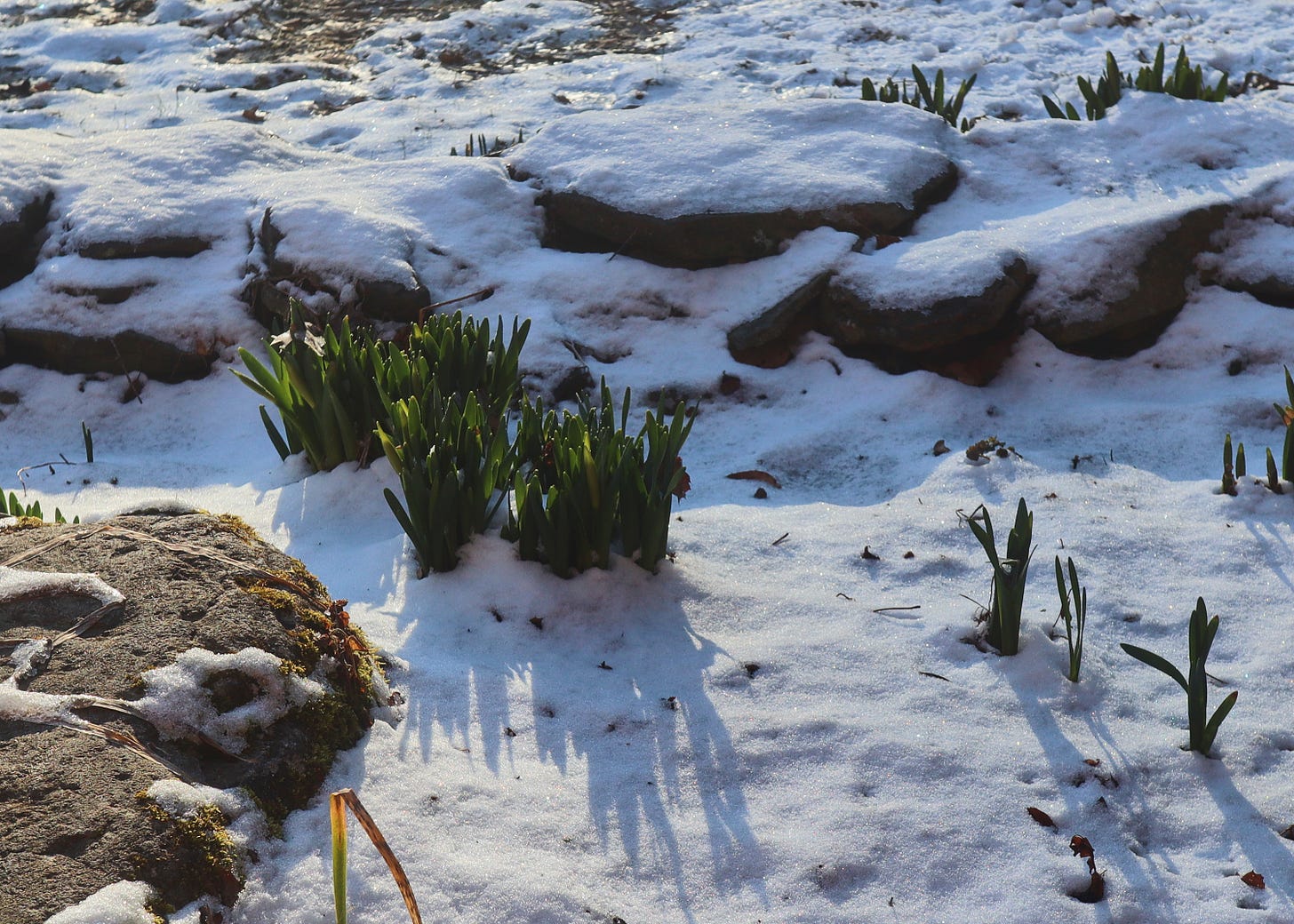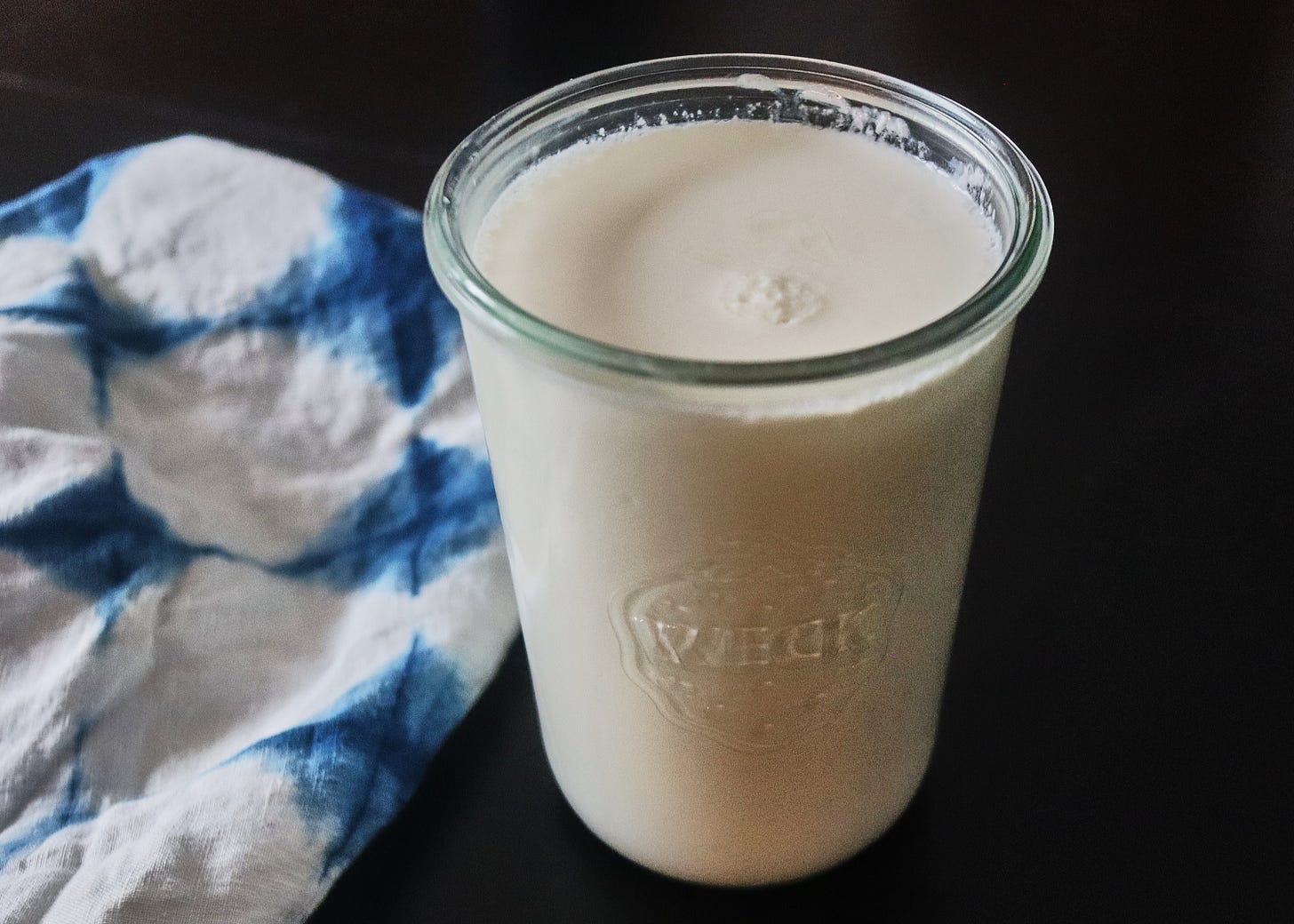March Full Moon: Homemade Yogurt (Laban)
Self-sufficiency, food sovereignty, and growing pains.
The slow trickle beginnings of the snowmelt, not evident in sight but in the swell of the brooks and tributaries rushing with cold water. Hardy green stalks that have yet to sprout springtime flowers push through lacy dead leaves and slice through crystalline snowy patches. An arrow of migrating birds fall organically into and out of perfect V formation as they make their way North. The peek of direct morning sun just over the mountain ridge. The Vernal Equinox up in the mountains doesn’t come as a burst of new life, as everything is still very deep in cold winter slumber for some more time yet, but if one pays attention, there are subtle signs of awakening.
In this transitional time on our mountainside, I feel the simultaneous pull to get out in the world to give and share and make a difference outwardly, and to replenish my reserves after already being pulled in so many directions, at the brink of exhaustion. As I write, there’s an ice storm outside, threatening to cut off our power with howling winds and fallen trees. On a clear night, the sky is bright with the waxing moon, casting stark moonshadows all around the icy landscape. I can see my breath. I feel so much gratitude for our material safety as I know at this very moment, under this very moon, there is a sinister genocide underway that we are all complicit in because our tax dollars are bankrolling it, and I rack my brain for ways to get through to our politicians who can end it with one phone call. It weighs heavily on my heart with every breath I take.
Within my own home economy, I’m still working toward teaching myself, bit by bit, how to transform excessive food spending into a frugal but robust pantry system that feeds my family well at a fraction of the cost of what we used to spend on groceries. If I look back, I’ve made tremendous progress in just the last few years. Whereas a few years ago I could easily spend $60 in groceries for one night’s dinner for two people, I now cook nearly all of our meals at home with a monthly budget that translates to roughly $5 per day per person. And we eat decadently.
As we whittle away at our excess, I pick up new lifelong skills. Spending too much money on bread? I’ll teach myself to make the best crusty loaves of sourdough at home. The kids have an expensive berry habit? We endeavor to gather and freeze and jam as many of the wild raspberries, blackberries, and cultivated blueberries that we can this summer. My husband and I hope that our retirement plan includes getting to a point where we can live off the land with minimal monthly upkeep costs. I also look at the plastic packaging that goes along with buying our staple ingredients and hope to minimize our waste stream in as many ways as I can.
I’m half Arab-American and thus my culinary needs for plain yogurt far exceed the average American. In our household, we eat laban with everything. As a side to Arab dishes, of course. But also a dollop on soups and stews, a cool, tangy base to pair with roasted vegetables or grains, I stir it into spiced lentils and rice, pasta sauces, morning oatmeal, my daughter’s occasional treat, mac n cheese. It’s a natural way to get our daily dose of probiotics and it feels good to eat living food. As we go through tub after tub of organic whole milk plain yogurt, the cost and the plastic waste add up. It’s high time to start making our own.
I learned how to make laban from my mom, who learned from her mom. Like so many recipes from the Arab diaspora, these recipes are so second-nature that they don’t live as a written-down recipe but as a knowing, a skill that gets passed down after doing it together over and over again. But like many of those same recipes, in the move from the homeland to our present-day home, substitutions for convenience ingredients became more common and the knowing went from a regular household practice to a novelty.
I think about how forced displacement can separate a people from their sovereignty, their land, ecosystem, and sources of sustenance. I think about how at this very moment, Palestinians in Gaza are being systematically starved out, not because they are incapable of procuring their own food against all odds but because their ties to their agricultural lands were violently severed and now the in-flow of food is being purposely restricted. Not unlike how the Irish Potato Famine was a result of similar colonizing forces upon the food system of a previously self-determined people.
But I digress. The basics of yogurt making are that you have two input ingredients: milk, and starter culture. While you can buy your starter culture, most people, myself included, just use a spoonful of yogurt they bought from the store as the starter culture that introduces the good strains of bacteria to the new batch of yogurt. You heat your milk to just under boiling- just to the point that steam and tiny bubbles start to form, then you remove it from the heat, and when it cools to the point that you can dip your finger in and count to ten without scalding yourself, it’s ready to add in the starter culture. You can also read more scientific and exact recipes online that require a thermometer, but this is the homespun way I was taught, and I’m sure millions of people before me have used a similar method. Then you leave it overnight in a warm place for 8-12 hours or so, and then it’s ready in the morning.
When I get to making my yogurt, the truth is I have been disconnected from my lineage of yogurt making at home. While I know the order of the steps from phone conversations with my mom and grandma, neither of them continue to make it as a regular practice. The subtleties that come with learning family recipes as an apprentice, watching over and over until it becomes second-nature, with plenty of opportunities to ask questions from a seasoned relative, have been lost. So when I start on my yogurt making journey, and my first batch comes out weirdly stringy and slimy, I look to the internet and reddit forums to determine what my issues might be. Apparently my batch was either cross-contaminated by wild yeasts in my kitchen due to all the bread baking I’ve been doing and/or the batch was not held at the ideal temperature for growing the good bacteria strains for long enough.
I could use a yogurt maker that holds the temperature to the exact degree for a predetermined amount of time, but I’m generally not a fan of single-use kitchen gadgets, as they take up space and use up electricity. So I try to do it the old way. I use a glass weck jar to incubate my yogurt in an insulated cooler, pre-warmed with a quart of boiling water to keep the yogurt jar warm. I know I don’t have as much control this way but I endeavor to keep trying until I can find the sweet spot. I opt for the long-term sustainable answer rather than the quick fix. Your mileage may vary. Like sourdough bread, making yogurt can come with its challenges at first and I recommend trying over and over again until you find a rhythm that works well for you. I’m still in my exploratory stages and I’ve learned a lot along the way but hope to continue learning and adding to my toolkit as I do.
This month, I don’t have a neat ending or way to tie it all together, but I do know that slow, sustained growth, and learning new skills and recipes in a fully embodied way feels more nourishing to me than having to constantly look things up online every time I want to try something new. This way I can draw upon my reserves and inner knowledge rather than feeling scattered like I constantly have to look to others for answers. Like the slow stirrings of the Vernal Equinox, on this day of the worm moon of March, I’m not quite in the flow of new growth yet. I’m in an uncomfortable season of growing pains, but I’m putting in the work so I can get to a better place in the future. I’m learning how to organize better, how to feed my family better, how to be more present and trust in the process. All we can do is stay humble, keep learning, and work toward a freer and more just world for all of the earth’s inhabitants.
Recipe: Homemade Yogurt (Laban)
Ingredients:
1 quart whole milk
¼ cup plain yogurt
Steps:
Sterilize your equipment in order to reduce the opportunities for cross-contamination. I use a quart-sized glass weck jar, boil all the parts for a few minutes, and set it aside.
In a clean saucepan, heat your milk until just before boiling. When it reaches the stage where it is steaming and bubbles are forming, remove it from the heat source and allow it to cool for approximately 20-25 minutes. When you can dip your (clean!) finger into the milk for ten seconds and not much longer without it scalding, you’re ready for the next step.
In the meantime, prepare your cooler by placing a quart of boiling water in it and allowing it to heat up. This is to create a warm, stable environment for the yogurt to set overnight.
Scoop ¼ cup of yogurt into your sanitized glass jar, and pour the warm milk over it. Stir briefly and cover the jar.
Put the covered jar in your pre-warmed cooler and leave it overnight, 8-12 hours.
When you reopen the jar after waiting overnight, the yogurt should be firm and set. Store in the refrigerator until ready to use.
Spell: Planting seeds
My coven has just celebrated our 6th anniversary of gathering together on the equinoxes, solstices, and cross-quarter days through the wheel of the year, and a theme that came up was spanning time. I thought about the Crone self and future self and how we want our stories to go, our actions to live on. How are we creating a net positive in the world? How are we using our privilege, power and responsibility?
Gather egg shells, or paper egg cartons, seed starting or potting soil, and seeds. Imbue the seeds with intentions of what you’d like to grow and manifest this growing season. Bury the seeds in the soil in the egg shells of egg carton. Water the seeds daily until they sprout. Care for them and transfer them to larger containers or to the outdoor soil when they have outgrown their starting nest.







I have been trying to perfect my yogurt recipe but I can't seem to get the texture spot on (it's a little grainy) but the flavor is close. There is a Greek market somewhat close to me (though it used to be much closer before I moved) that just RUINS you for any other yogurt. Seriously, this stuff is magical. Thick (almost like labne) and super tangy. I've been trying to duplicate the recipe so I don't have to travel quite so far to get my fix. Thank you for sharing your method here.
Just lovely—I appreciate the encouragement. This spring marks my first attempts at making yogurt at home as well. With 4 children, the plastic cartons were getting excessive! It’s so nice to just be working in glass now. We are on our 5th batch since I started!